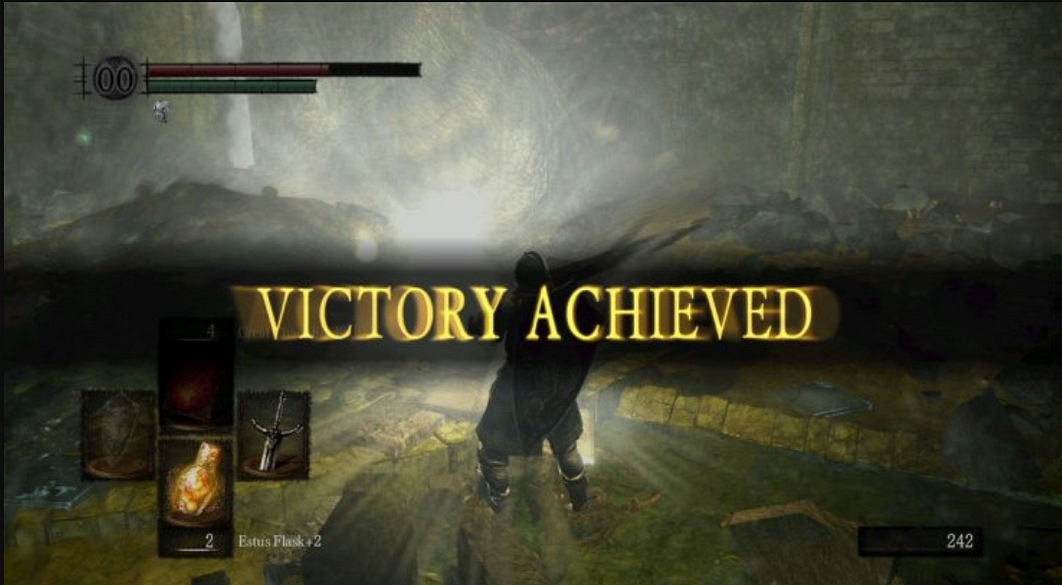
Featured Blog | This community-written post highlights the best of what the game industry has to offer. Read more like it on the Game Developer Blogs or learn how to Submit Your Own Blog Post
How Difficulty Impacts Motivation in Game Design
Continuing my thoughts on difficulty design, I want to spend a few minutes discussing player motivation and how it can push someone to keep playing a game, or cause them to bow out of a game if they feel stuck.


I’ve done a lot about the nature and design of difficulty as of late, and it was the topic of our recent gamedev roundtable discussion on the Game-Wisdom Youtube channel. When we talk about difficulty, it is intrinsically linked to the player’s skill level and what kind of experience they’re looking for. For today’s post, I want to expand more on this and talk about what difficulty and the experience mean from the consumer’s POV.
Reasons for Playing
If you’ve studied game design at all, the Bartle player type chart has probably been discussed. The Bartle test is a way of defining what kind of player someone is of a game based on four distinct groups (but you can occupy more than one group) —
Killers: Players who are interested in proving they are the best among their peers, getting the top rank, #1, etc. and is PVP-focused
Achievers: Players who are interested in completing a game and conquering challenges that the game presents itself, oftentimes PVE-focused
Socializers: Players who are interested in interacting with other people and playing with (and meeting new) friends, multiplayer and role-playing-focused
Explorers: Players who are interested in finding new things, secrets, etc.
My problem with this test is that it was designed around MMOS and MMOGS and I don’t think it holds up 100% as it did during the MMO boom. I would add something like “Experiencer” for someone who is interested in the story and world and wanting to experience them, such as RPGs or survival-styled games.
Regardless, understanding player motivation and psychology is something very important to game designers, because this is the first real question you need to answer after figuring out your core gameplay loop: who is this game for? That one question will impact everything from the design and systems to your marketing and PR.

The gameplay you’re designing will impact who you’re marketing to, but that doesn’t excuse you from doing UI/UX work
I feel one area that Celeste slipped up in was the messaging for the intended audience. From the outside and discussions, people tend to focus on the story, how it impacted them, and the game’s assist mode. However, those three aspects completely ignore the gameplay which is hardcore platforming; possibly the hardest commercially released technical 2D platformer. That mixed messaging could also be why the churn rate for the game is so high and so few of the consumer base saw the game through to the end. Whereas Dark Souls, and other difficult games, message their games as being challenges — leading to high churn, but often higher clear rates.
Even though getting your messaging and your consumer base down are vital, this is where a lot of developers will often stop and become laser focused. The problem is that if you only look at your hardcore audience and no one else, you’re not going to understand pain points and UI/UX issues with your game; a topic I have very much talked about at length. Good design is about not only understanding what the consumer wants out of your game but what aspects can get in the way of that.
The Motivation of Play
Regardless of who you are aiming your game at, there is a basic aspect of what motivates someone to play video games: Progress. Progress hits at not only the skill/difficulty curve of a game, but all aspects of moving from beginning to end in a title. When someone is playing a video game, no matter what kind of gamer they are, they need to be experiencing momentum — something. anything. that is moving forward. For each kind of player, they are looking for something different to push them forward.
If you’re interested in achieving and mastering a game (like me) then I would expect to see new gameplay elements, challenges, mechanics etc. If your entire game is just about doing the same exact thing with no growth, I’m going to lose motivation to keep playing. However, someone who is interested in a story or experiencing what the game has to offer will be motivated differently. Likewise, competitive players couldn’t care less about achievements or beating the singleplayer mode, when they’re playing to see who the best is in competitive or PvP modes.

different audiences have different motivations for playing, and will leave if their’s is not being met
The important point is that the player should never feel like they’re “stuck” — that there is no route to improvement or success. This is often when difficult games have high churn: someone gets stuck, doesn’t see a way to get around it, and then they quit. Sometimes, people may return to try it again, but most likely they’re going to move on to another game. For the multiplayer-focused crowd, having an online community before launch is vital — if on day one of your game people can’t find matches, that is a red alert situation and could easily lead to your multiplayer fans leaving in droves.
Being in Control
Continuing from the point about momentum, consumers want to be in control over their experience. They want to feel like they are the ones who are either moving the game along or understanding what they need to improve on to succeed. When a game does not present its mechanics properly, or a difficulty spike occurs, it’s easy to feel like there is no path forward.
This was one of my complaints about Sekiro vs. other From Software titles. In Sekiro, the design is explicitly set up and balanced around one strategy for combat to succeed; there is no room for anything else. If you get stuck playing the game or try to play it in a way that the designers didn’t want you to, you are not going to be able to win at all. Conversely, the other soulslikes are set up to allow for different options that can be viable. If you’re stuck at a section, you can do the following:
Upgrade your gear
Level up your character
Switch weapons/strategies
Call in help from other players or NPCs
Most often, there is a plan B, C, and even D, that the player can try. This is one of the attractions of the variance in roguelike design: where there is no one strategy but creating one out of all the various items and equipment that can show up during a run. The best kind of difficulty is the one that the player chooses for themselves, however, there is one caveat to that.
Changing the difficulty after playing the game is a lot harder to motivate someone to do; especially if it requires them to leave the game to do so. In a follow-up post, I want to expand on this more and why the best difficulty modifiers — making a game easier or harder — occur from within the game space.
For multiplayer games, therefore having some kind of ranking/rating system and/or multiple modes is important. You never want your hardcore, casual, and core, players to be interacting directly with each other, as each group has different reasons for playing and skill levels.
There must always be something in the game that is driving someone to keep playing. Once that investment is gone due to difficulty, repetitive design, pacing issues, etc., it will lead to player churn.
The Perception of Difficulty
On our roundtable, Tomo Moriwaki brought up a good point — difficulty as a concept is not based on the designer or the game, but how the player approaches playing it. Someone who is the top platformer player of all time could probably crush Celeste or Super Meat Boy and wonder why people had trouble with it. That perception is often where developers end up failing the skill curve of their game: not understanding what elements create difficulty and either ruining their difficulty with a game that doesn’t grow, or one that is so difficult, only the most hardcore (and smallest) percentage of the fans will play it. Being able to examine a game’s design separate from your own opinions on a genre is an important trait of being a good designer. As a follow-up to that point, just because you like or dislike something is separate from whether the design behind it is good.

Difficulty for the sake of it is not good design and often leads to the highest churn rates
Earlier, I said that players want to feel like there is some route to progress. If someone feels like there is no hope of ever making it through a game, they’re going to stop playing and never come back to it. If they lose their motivation for playing a game or see that the title is not catering to their specific reason, that also leads to people quitting.
As an aside, this is often why games that try to mix both single and multiplayer crowds often end up with one group being the dominant focus, and the players on one side being let down.
Understanding what aspects create difficulty in your game is vital for not only accommodating people who want it easy but making something that people can sink their teeth into if they want. I’ve said this countless times, poor UI/UX makes a game more difficult, but that is not good design. There is a difference between feeling like the game is challenging you vs. fighting a poor UI or UX that are making it frustrating to even begin to play the game.
Fighting the game is often something we see in titles where there was either no playtesting done, or the game was developed in an echo chamber with people who see no problem with leaving frustration in. The concept of “gamer tax” or having to put in work to experience a game, only works if someone is having a good time. Take Dwarf Fortress as an example: if you were to ask fans what makes the Dwarf Fortress experience work or the reason to play it, I don’t think anyone is going to say “Ascii graphics and a lack of onboarding.” Streamlining the learning curve and improving the UI/UX are just some of the aspects that Kitfox is bringing to the published version, and that may be enough to get me to try the game out.
You need to remove as many barriers as you can as a developer if you want people to play your game. Difficulty is not the same as challenge or depth and by itself — whether it is easy or hard — does not make a good game.
If you enjoyed my post, consider joining the Game-Wisdom discord channel. It’s open to everyone.
Read more about:
Featured BlogsAbout the Author(s)
You May Also Like







.jpeg?width=700&auto=webp&quality=80&disable=upscale)



.jpg?width=700&auto=webp&quality=80&disable=upscale)




